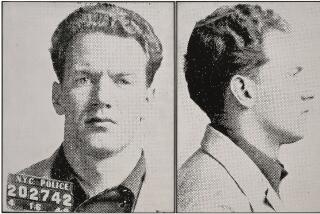A poster child for fair use
- Share via
Most Americans are familiar with the ubiquitous poster by L.A.-based street artist Shepard Fairey of then-candidate Barack Obama looking off into the distance, pensive yet resolute, with the word “Hope” emblazoned across his chest. No image more clearly captured the excitement and expectations of that historic race.
What Americans were not aware of when the posters were first plastered up across the country is that the image was drawn from an Associated Press photograph of Obama at a National Press Club event in 2006. Fairey found the photo on Google, traced Obama from the original shot by Mannie Garcia and filled it in in beige, white and blue.
The rest is history. Obama was elected and became leader of the free world, while Fairey got bogged down in years of litigation with the AP. The legal question was whether he had violated the company’s copyright by using the image — uncredited and uncompensated — for his own work or whether, as Fairey insisted, he had made “fair use” of the photograph and therefore wasn’t bound by copyright restrictions.
This week, the lawsuit came to a sudden end when Fairey and the AP announced that they’d reached a tentative settlement. But for the rest of us, tricky questions remain as to where to draw the line between art and theft.
“Fair use” is the legal concept that guides whether and when copyrighted material may be reused by another creator. It has become especially important in an era when digital technology allows artists to, with the press of a few buttons, use other people’s finished products as raw material for new works.
Federal law has set guidelines for determining what is or is not a fair use. Courts consider, for example, how much of the initial work was used, to what degree the original work was “transformed” in the subsequent work and whether the existence of the new work in effect reduces the potential earnings of the original work.
Our view is that although copyright laws are designed to protect copyright holders, they are also supposed to encourage creativity and innovation. Fairey made some clear mistakes — the biggest was that he apparently lied at the outset about having worked from Garcia’s photograph — but in the end, we believe the work he created was substantially transformed from the initial image. The two were different enough that it’s highly unlikely he negatively affected the market for the initial work.
The poster that resulted was no longer a straightforward news photograph of Obama, but a stylized, blue pencil drawing that conveys an entirely different feel, a different Obama and which mimics the propaganda posters of the mid-20th century.
Meanwhile, as part of the settlement, the AP and Fairey announced that not only aren’t they going to battle this out indefinitely, they are planning to collaborate in the future. Thus, the adversaries — the multinational corporation and the street artist — become business partners. Long live capitalism!
More to Read
The biggest entertainment stories
Get our big stories about Hollywood, film, television, music, arts, culture and more right in your inbox as soon as they publish.
You may occasionally receive promotional content from the Los Angeles Times.










